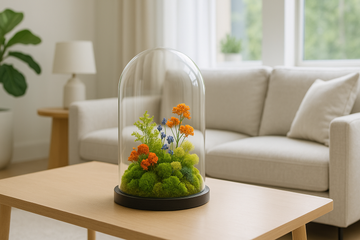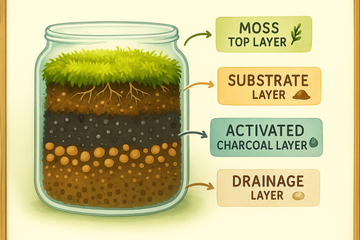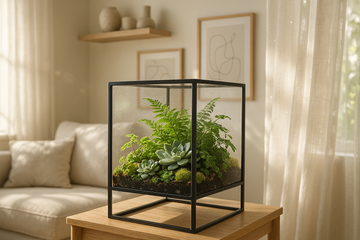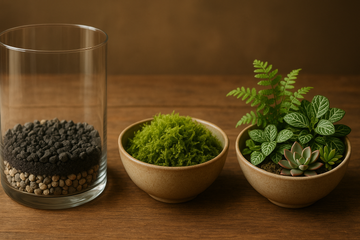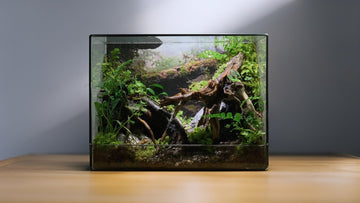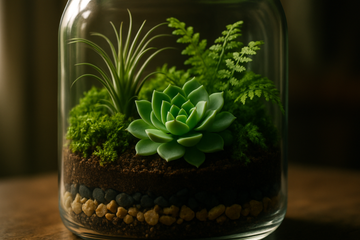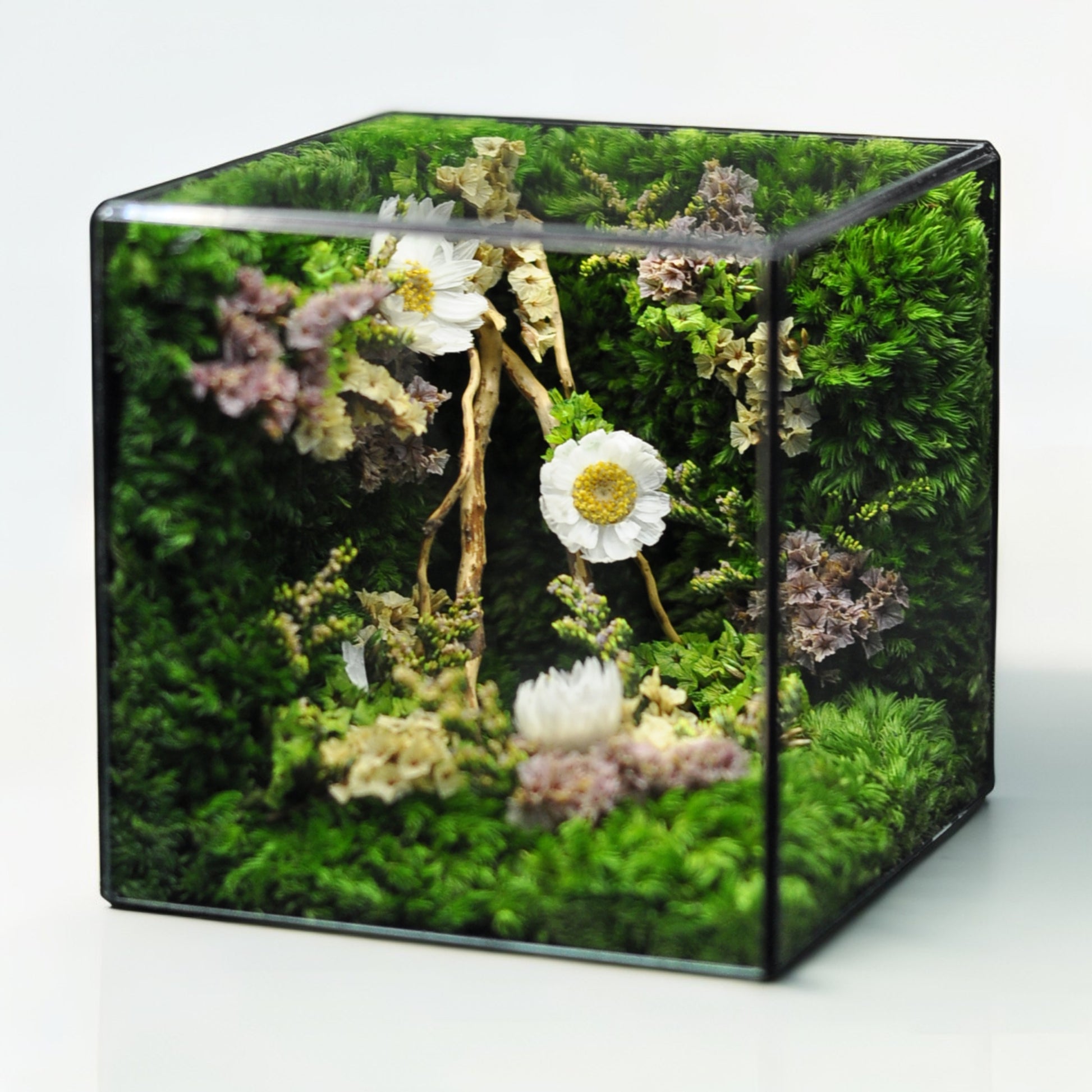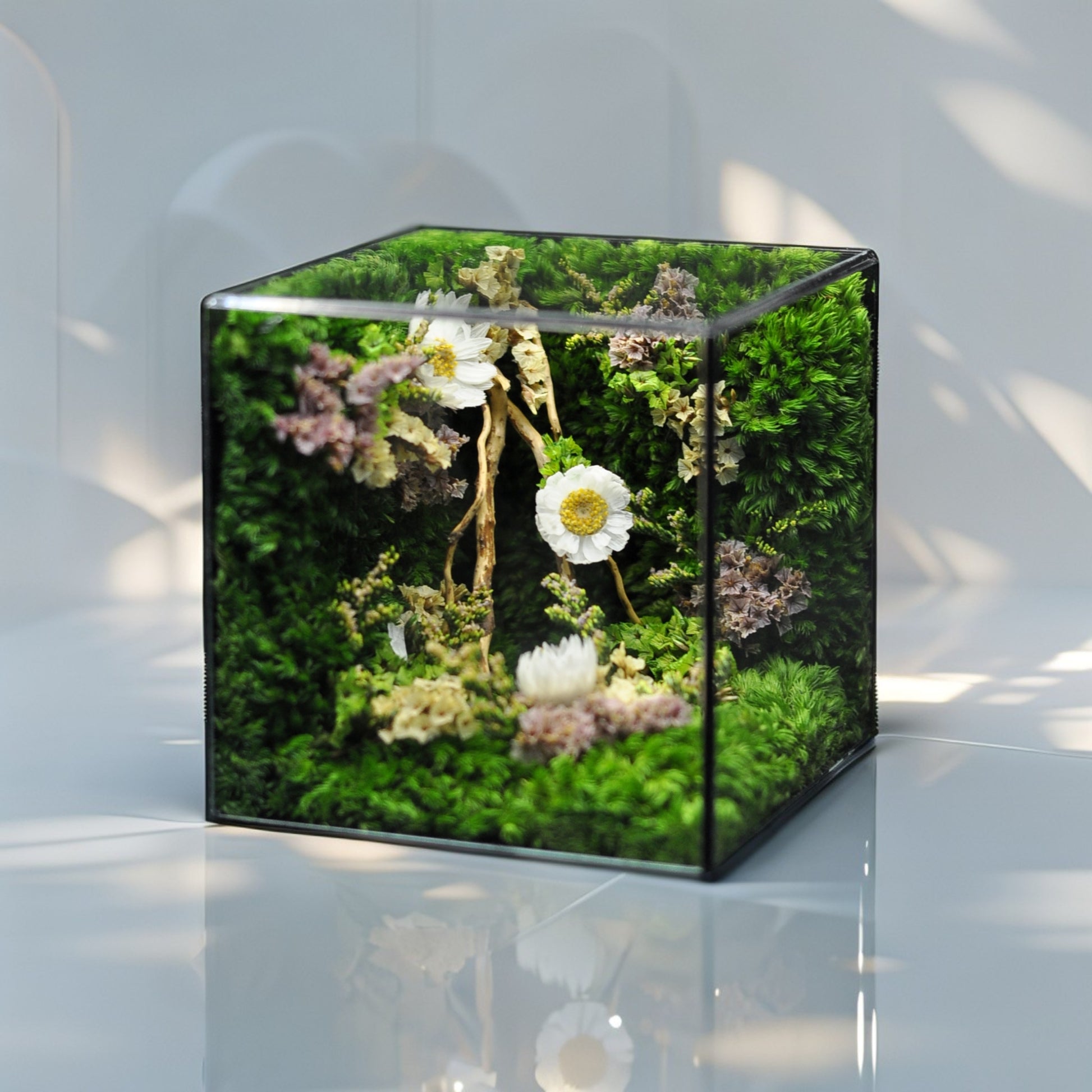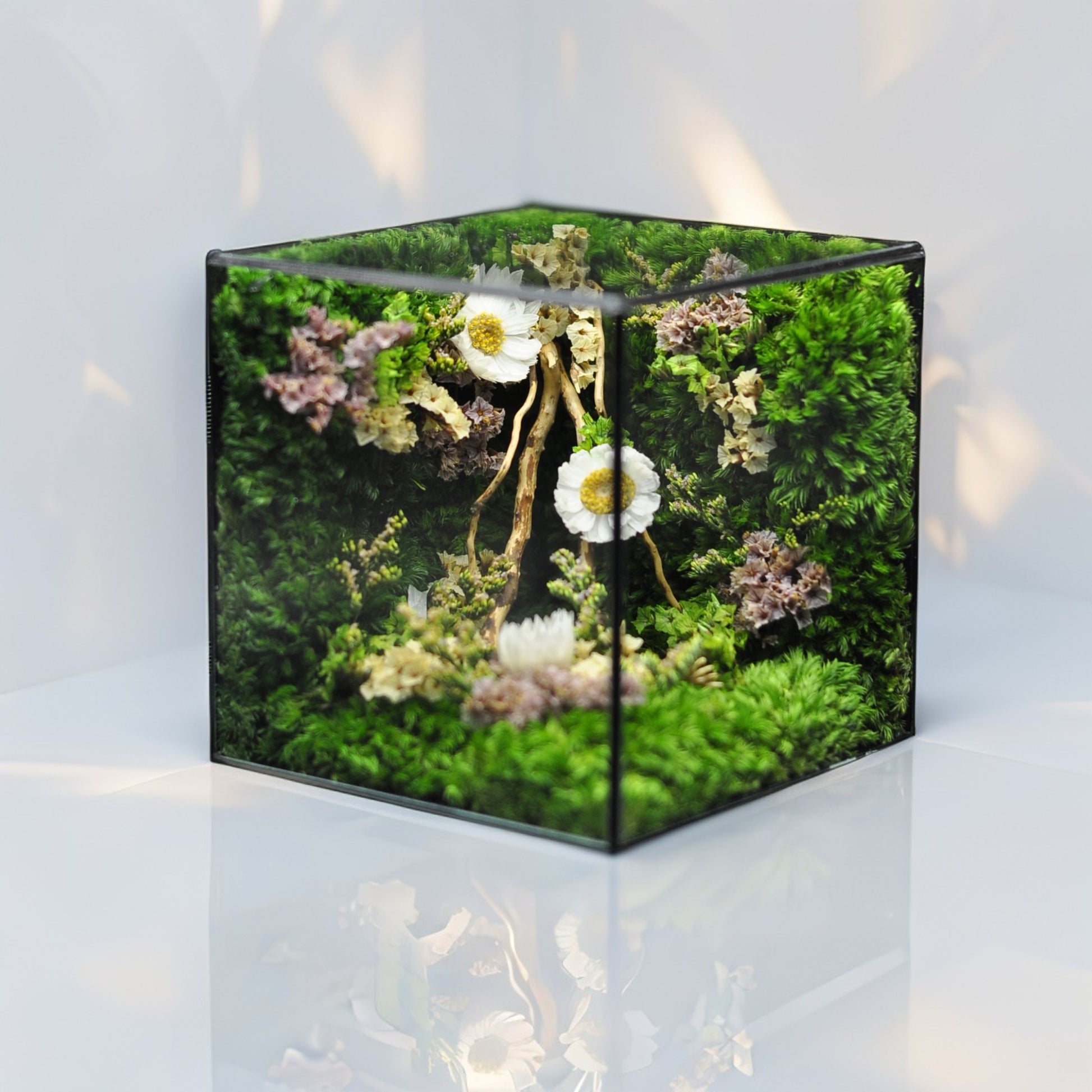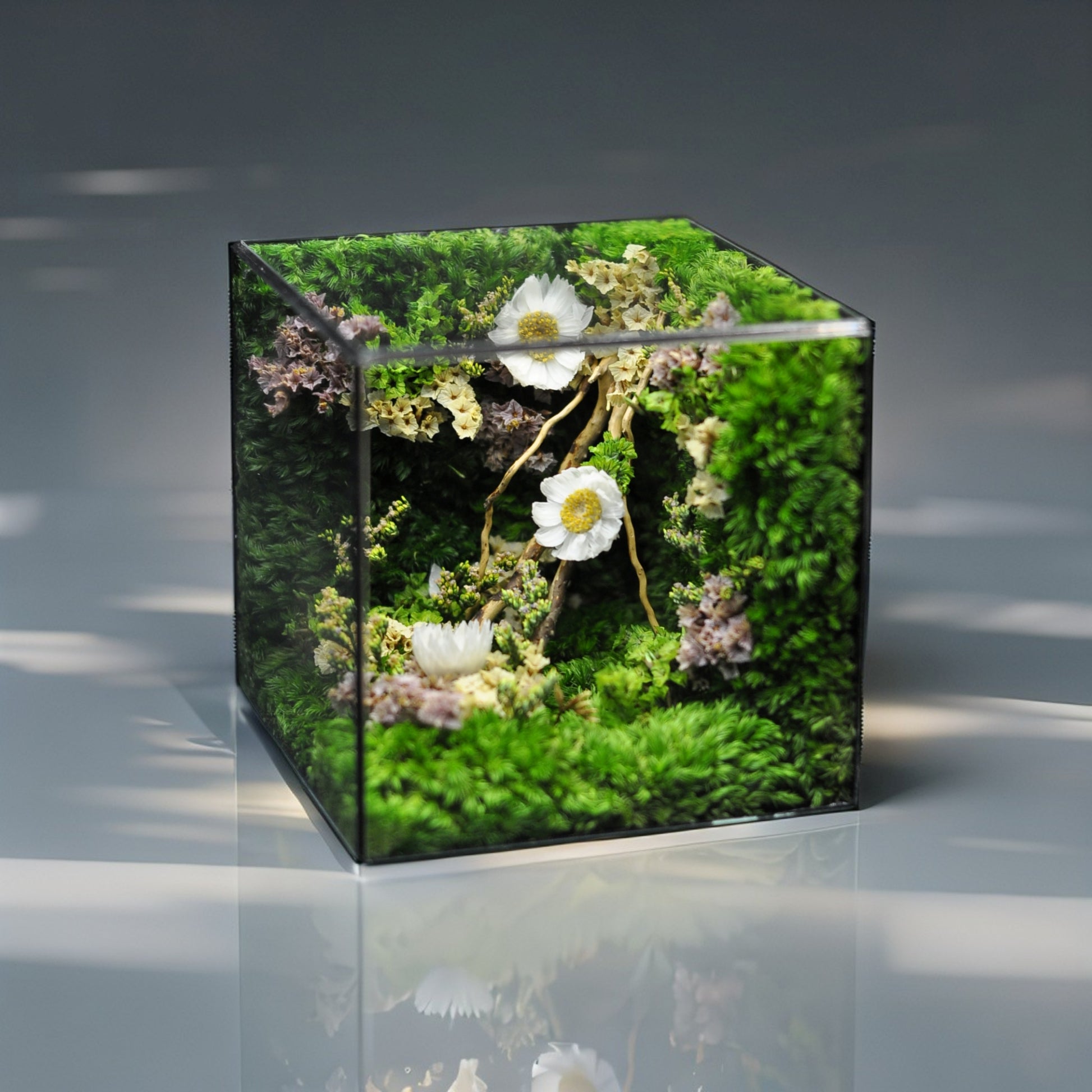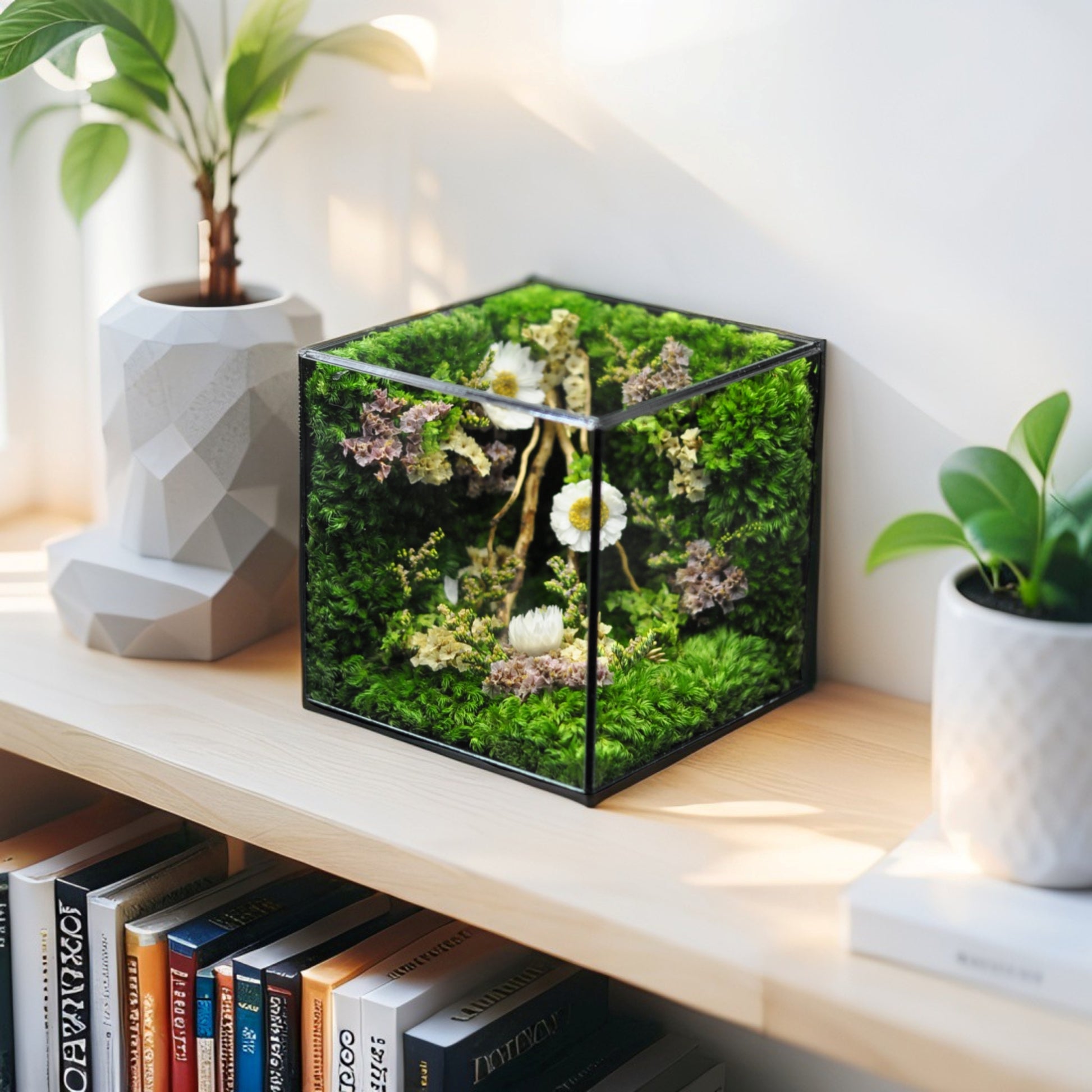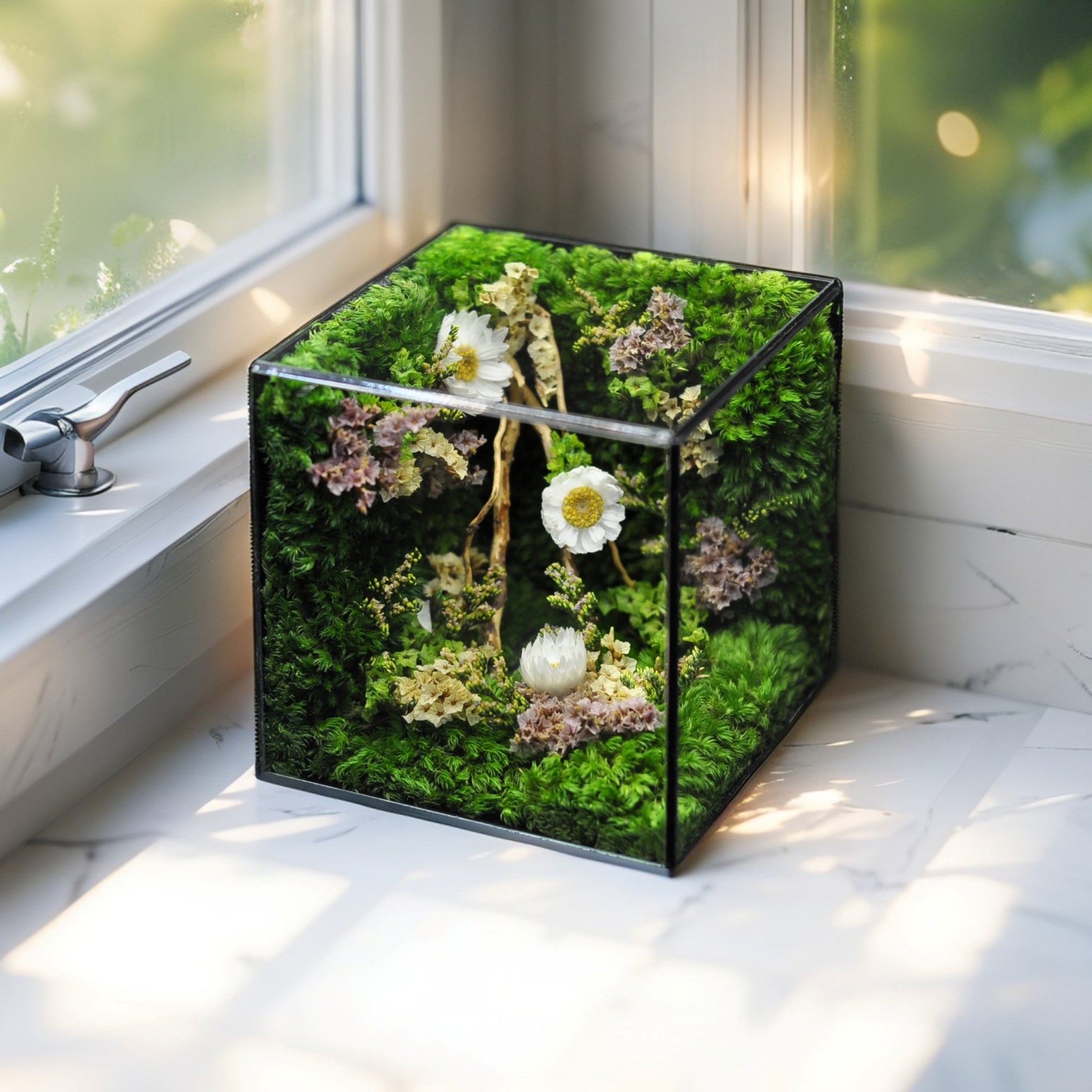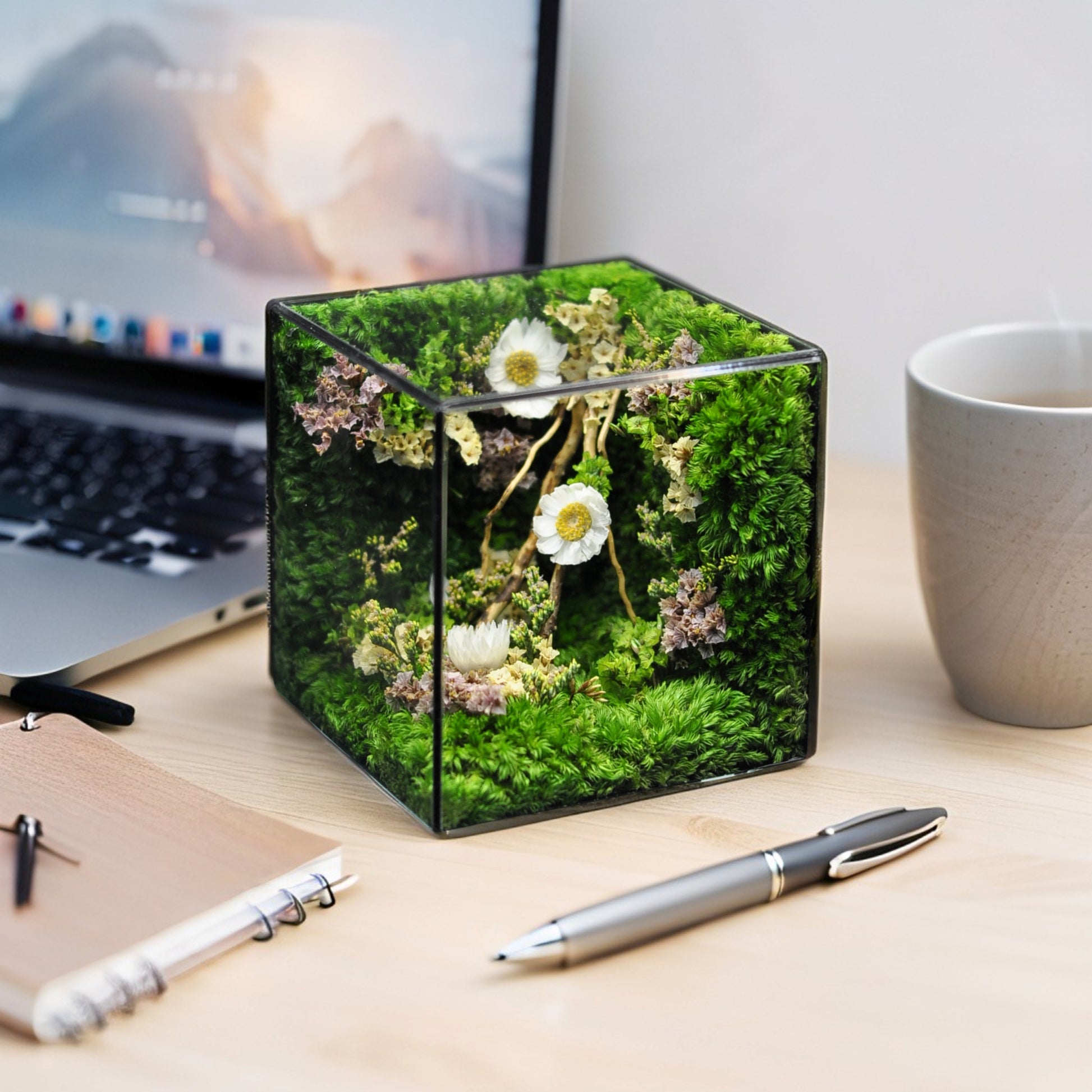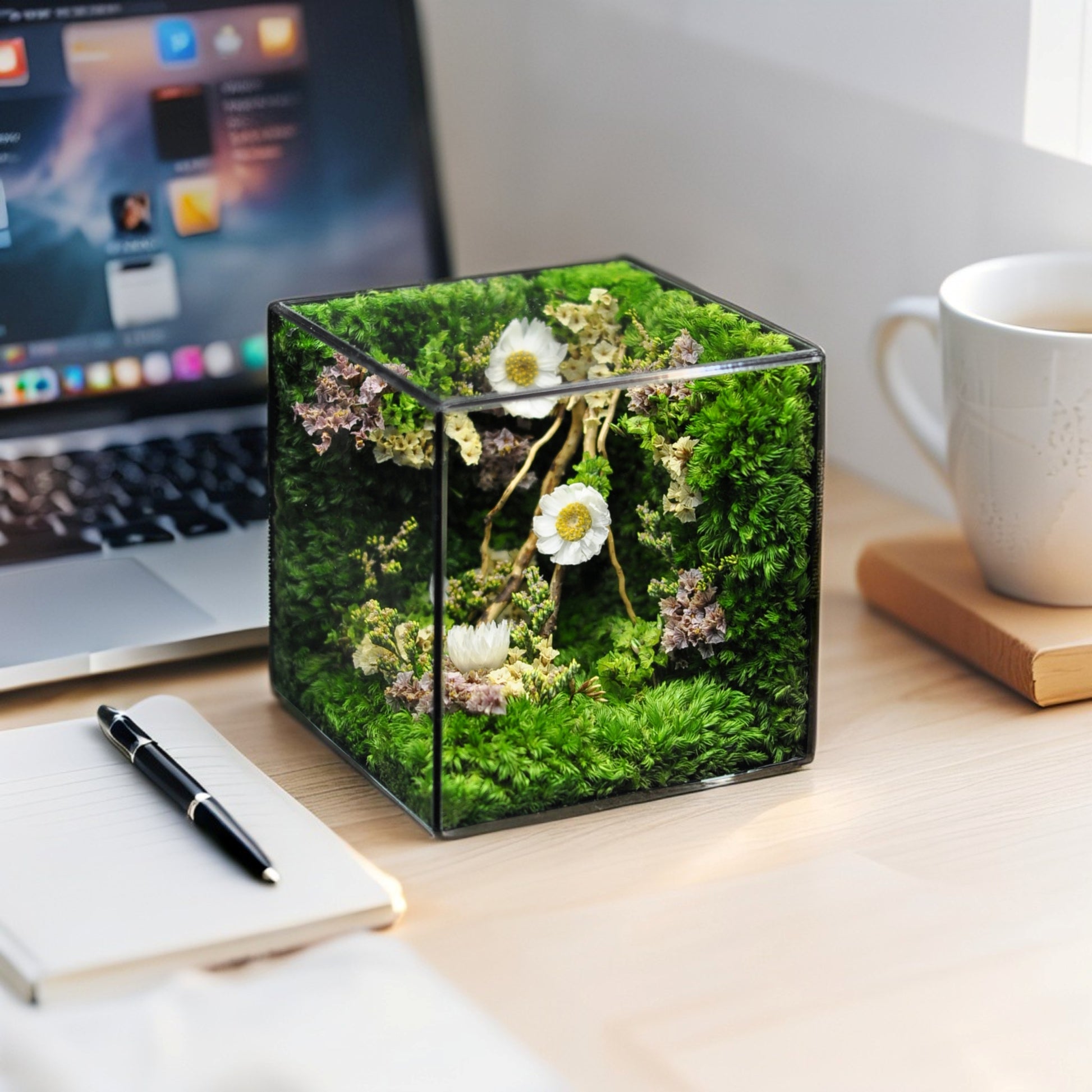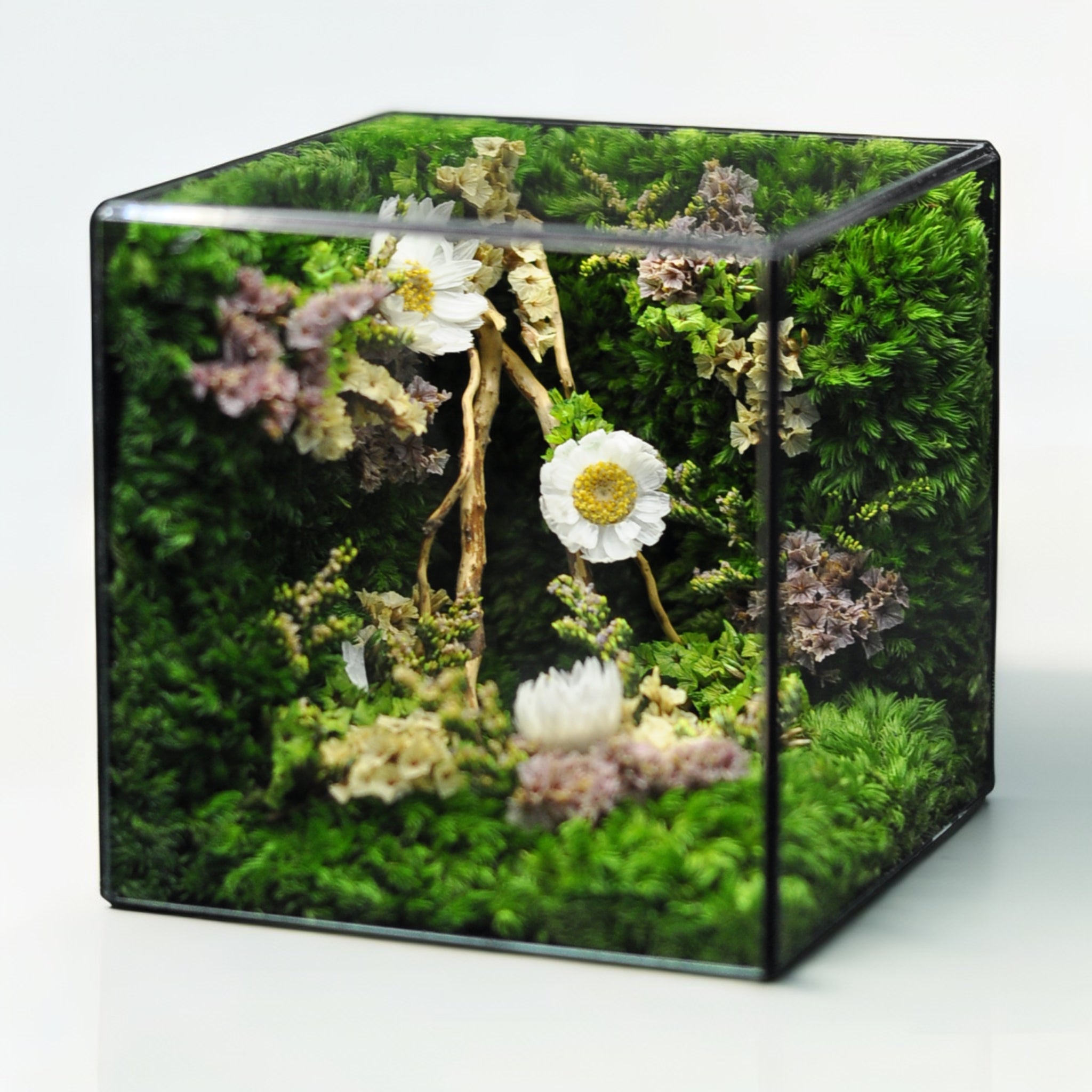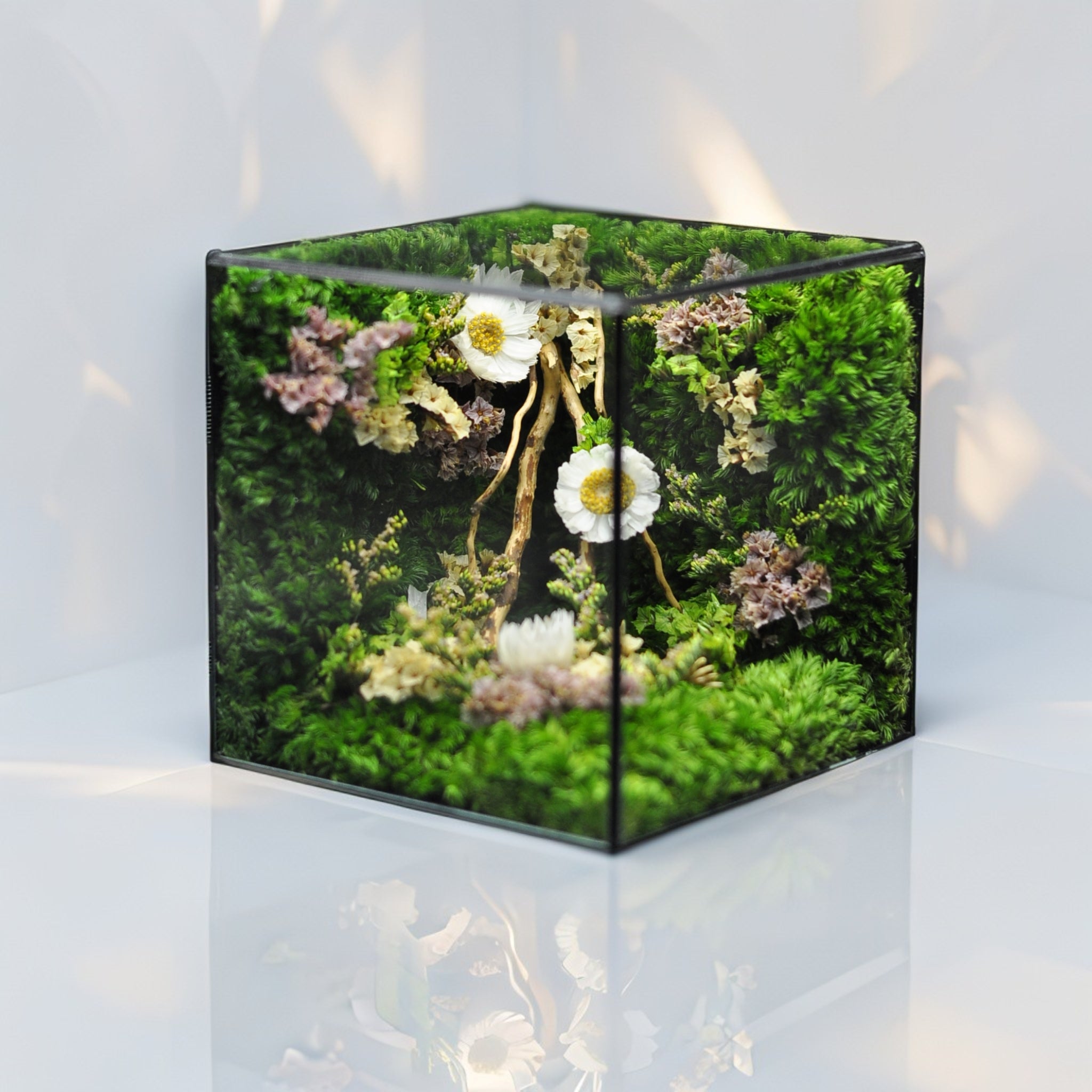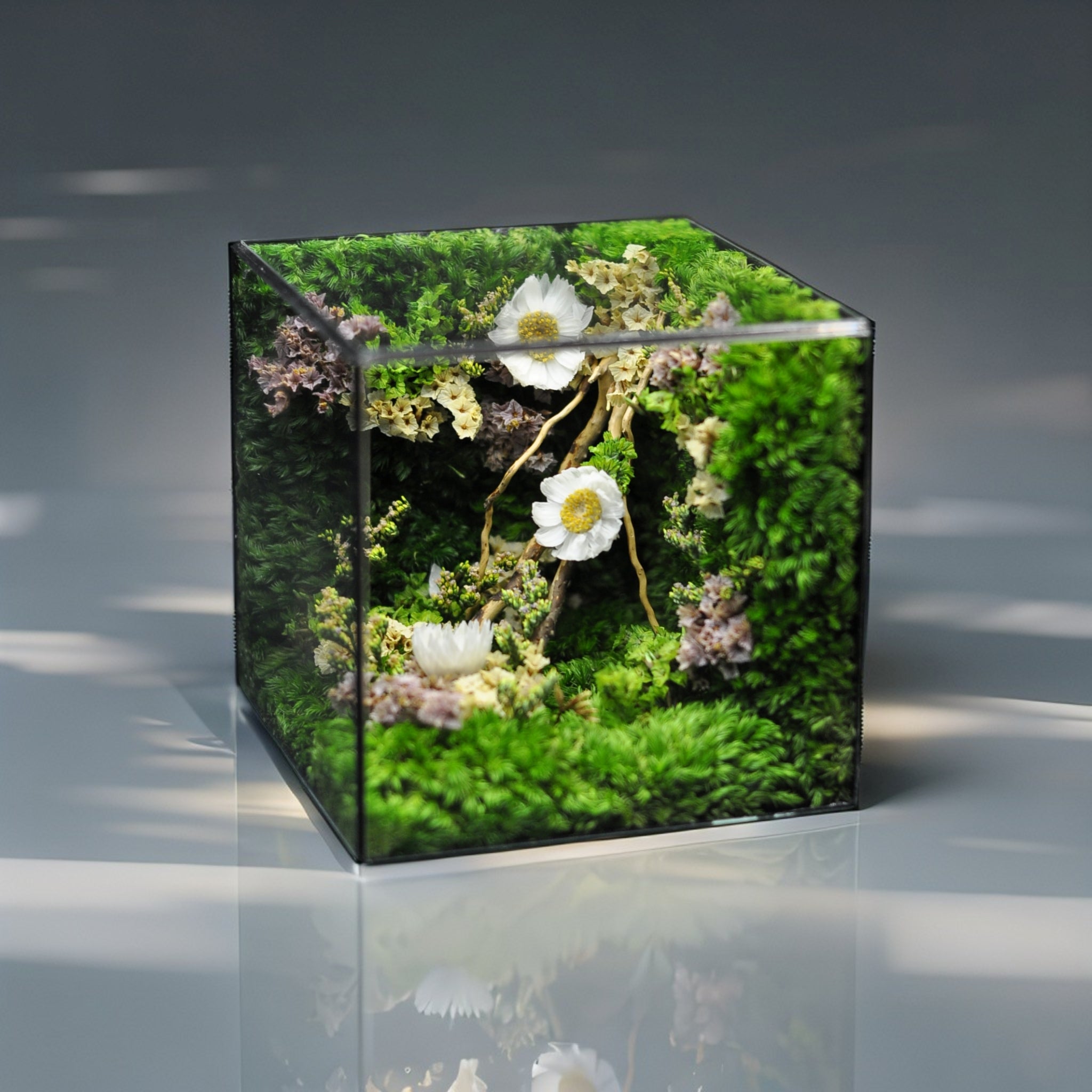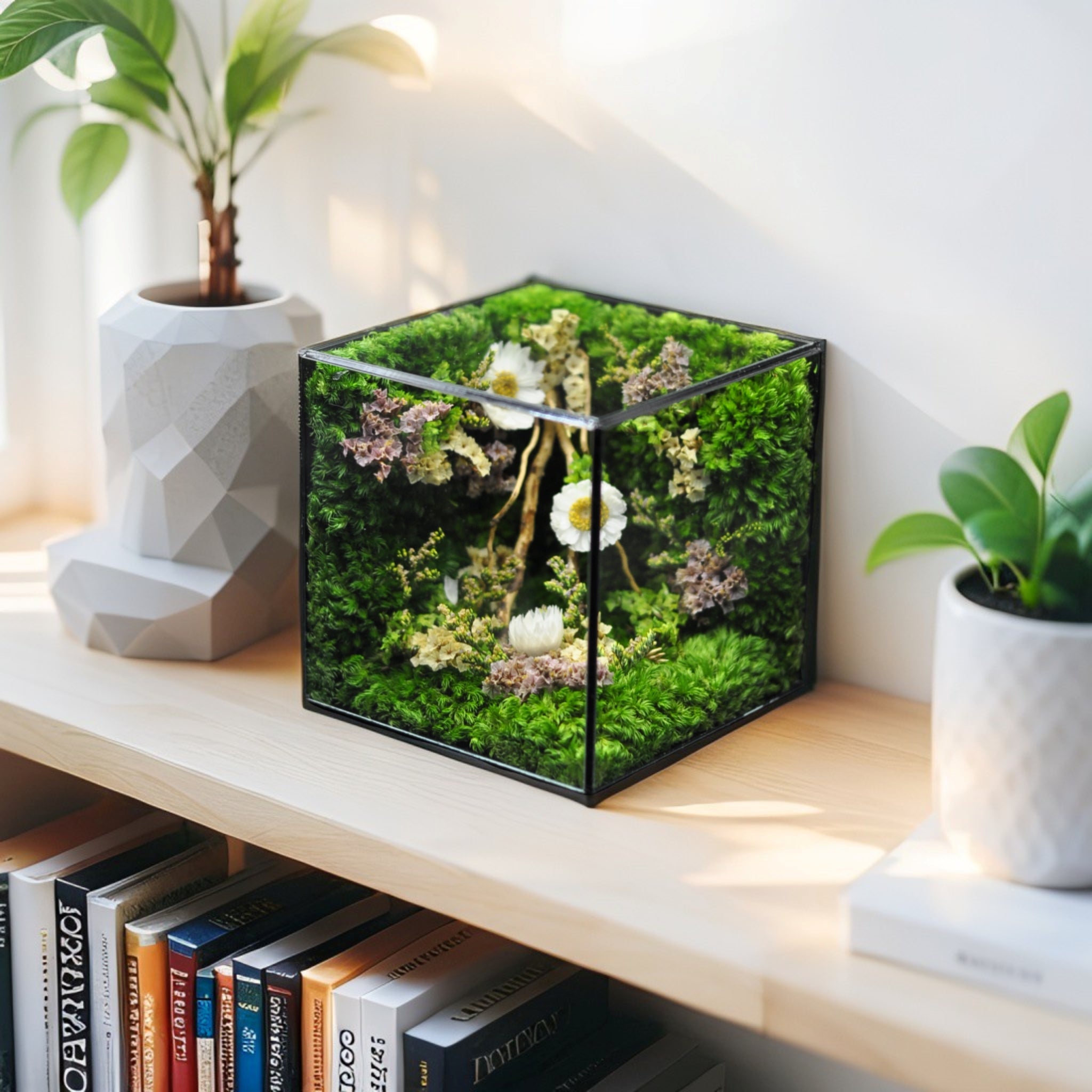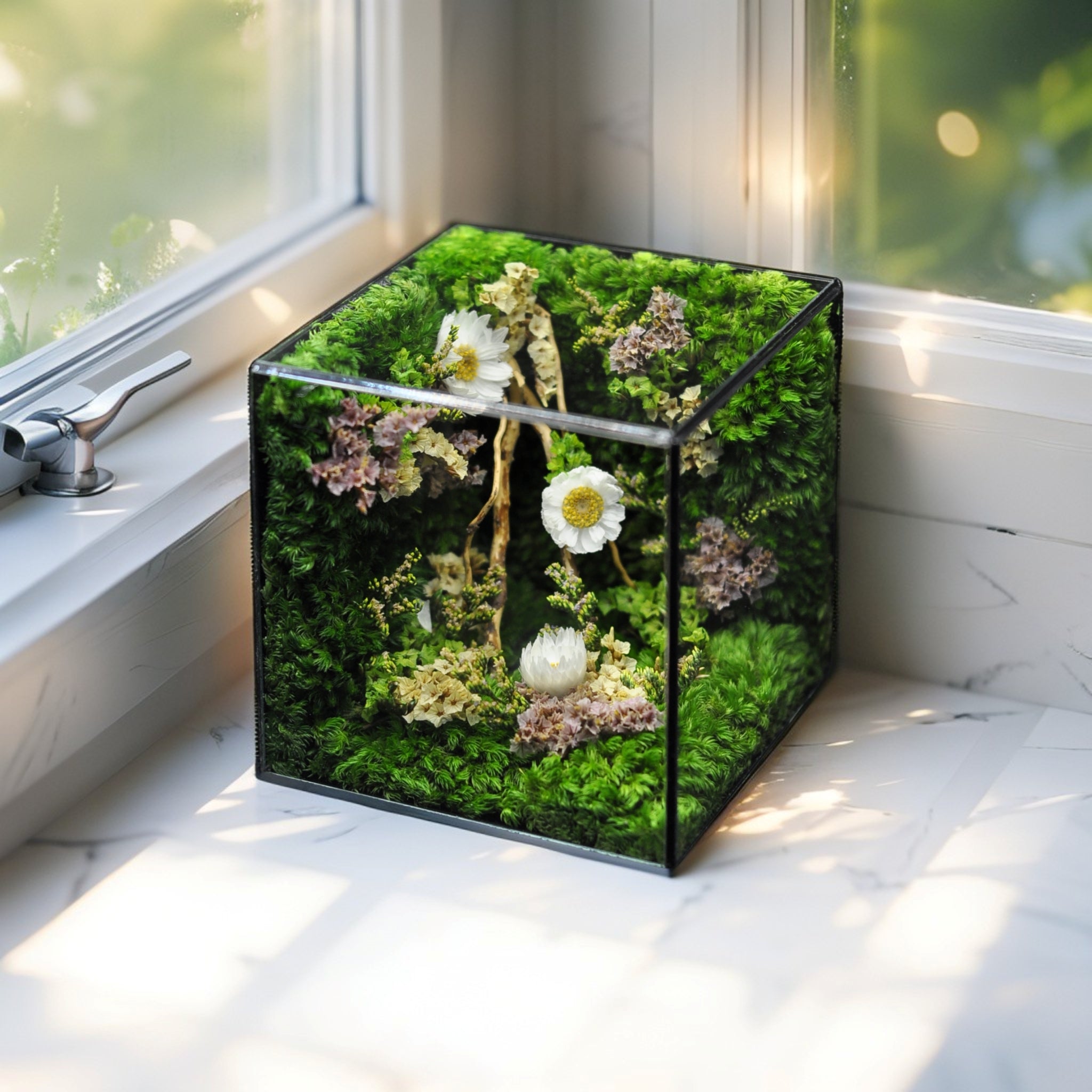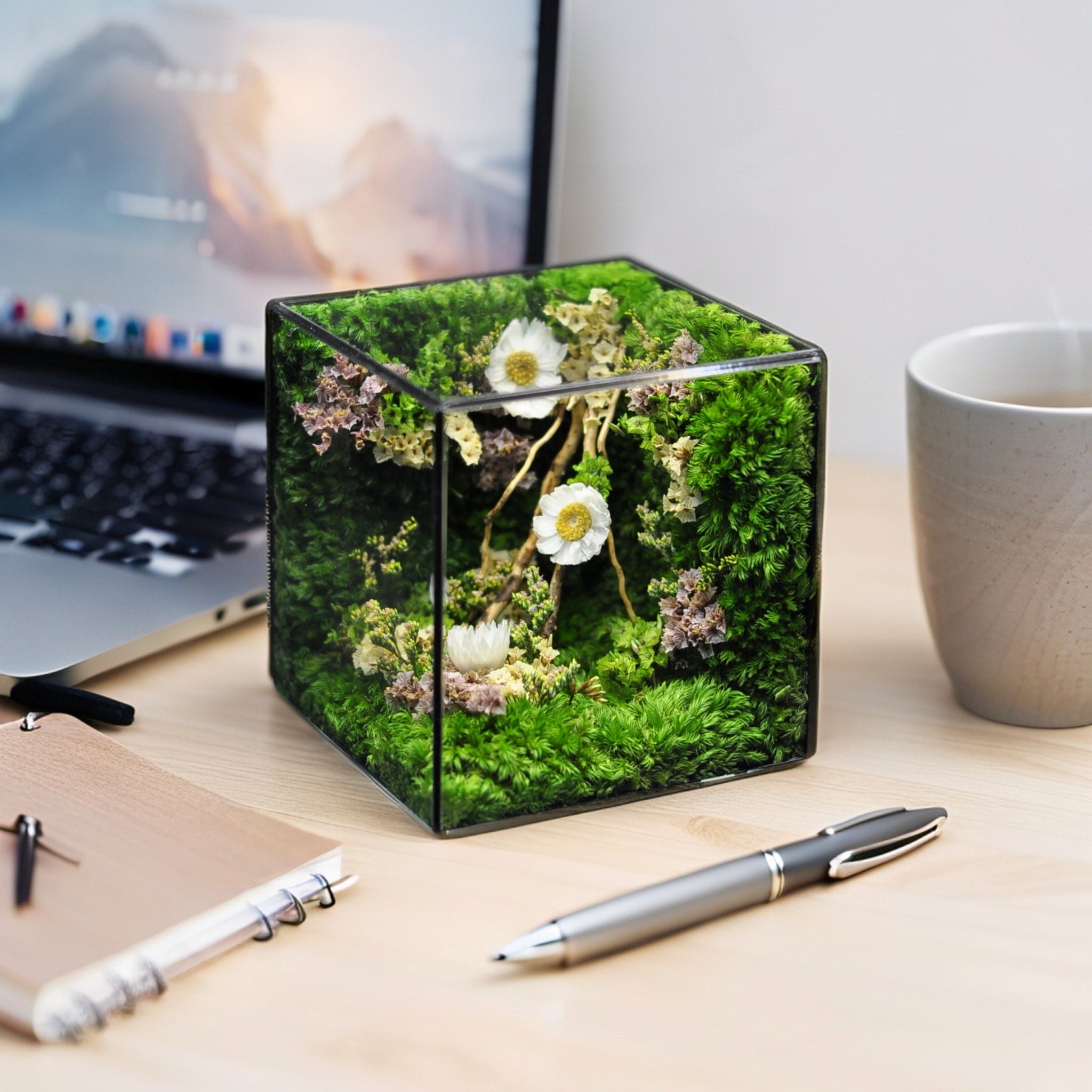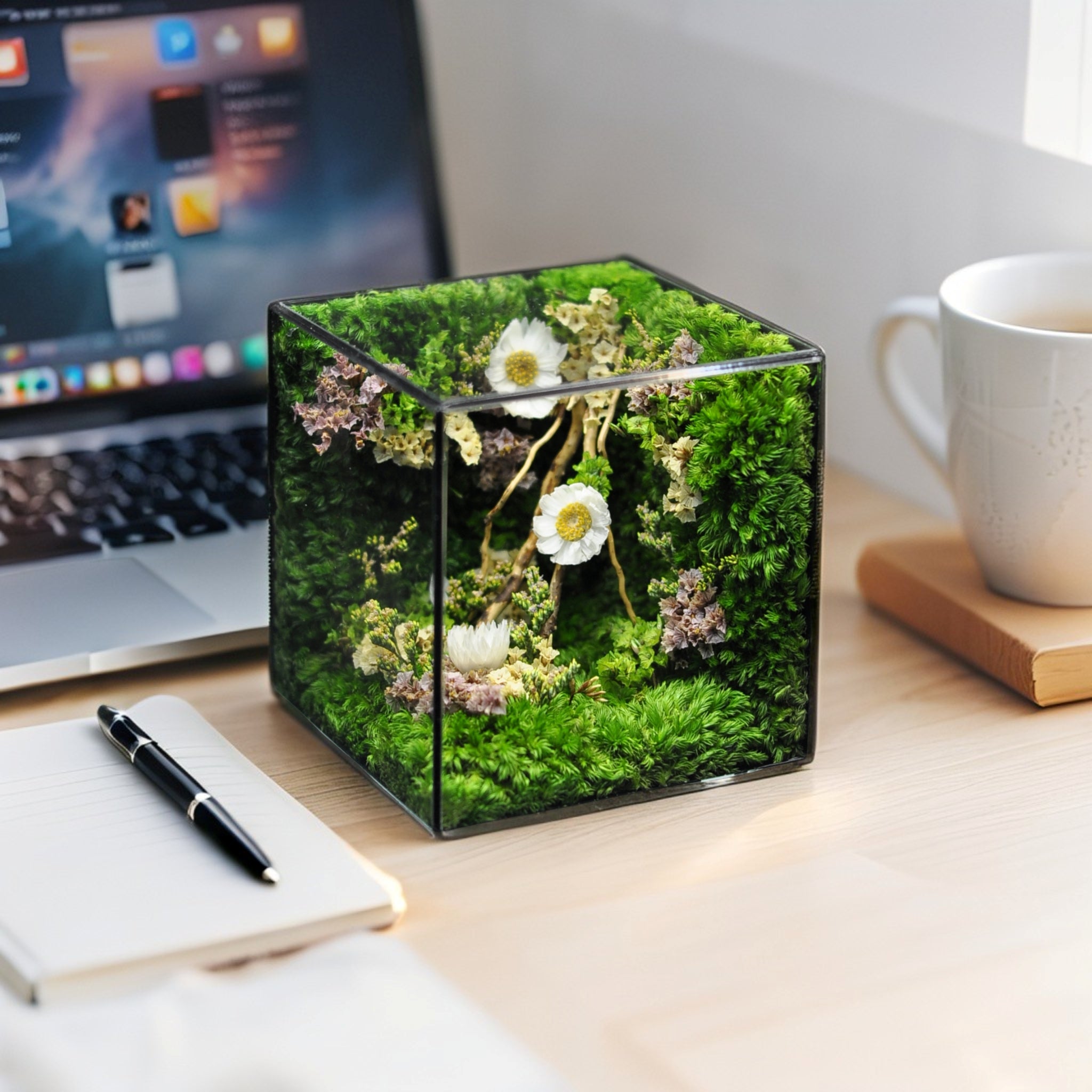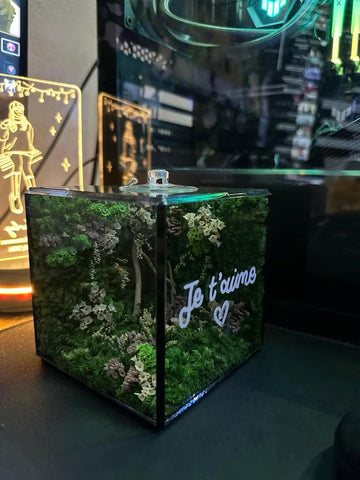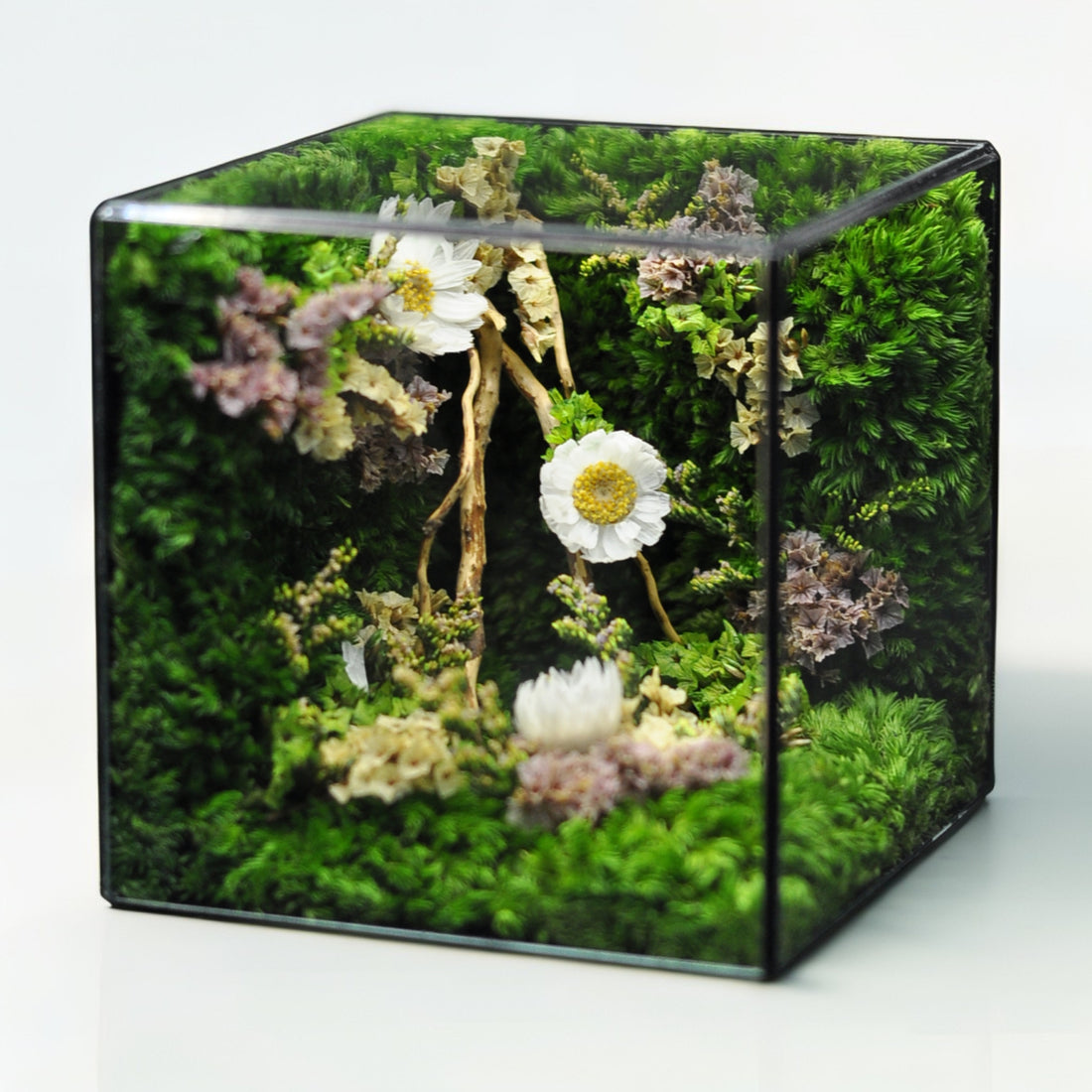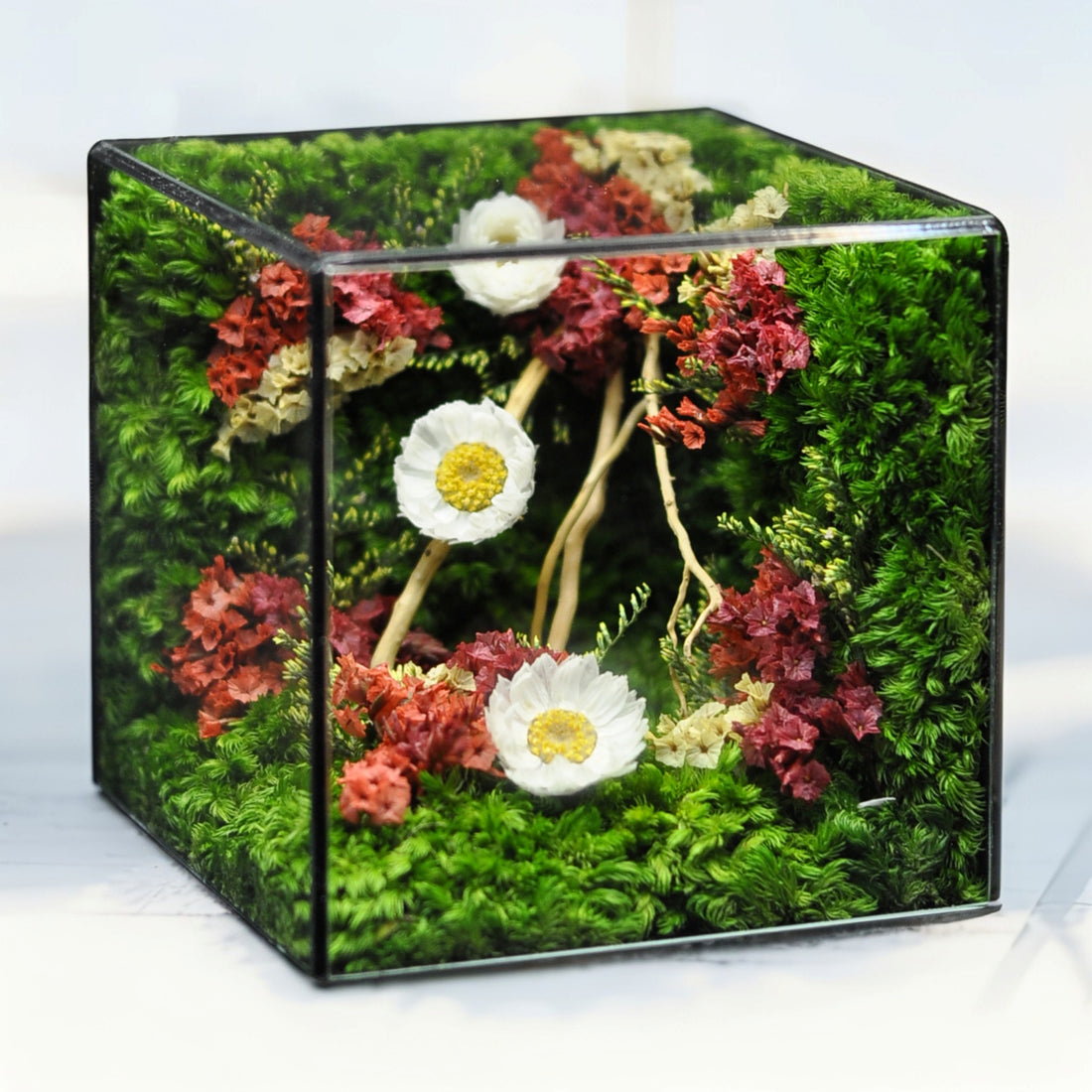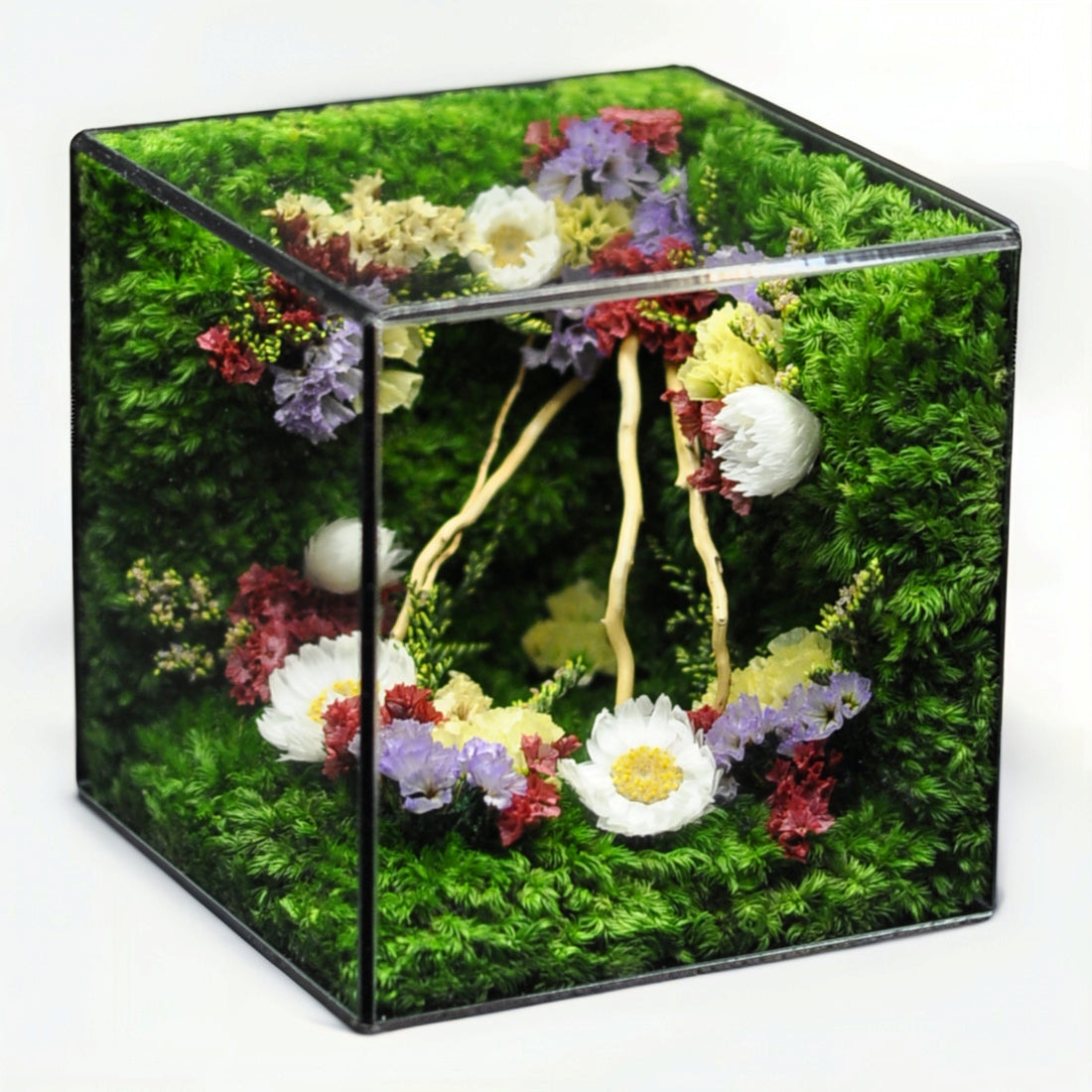Key Takeaways
Preserved terrariums combine nature’s beauty with near-zero maintenance, making them perfect for busy lifestyles and any lighting condition. In this complete guide to the 10 best preserved terrariums to buy, you’ll learn how to choose between moss-only, floral, or mixed-plant designs, pinpoint trusted retailers, and master simple care tactics to enjoy lasting freshness.
- Embrace effortless greenery with preserved terrariums: These sealed displays lock in peak plant textures and colors, delivering perpetual natural beauty without watering, sunlight, or pruning.
- Differentiate preserved vs live terrariums for stress-free style: Unlike live terrariums that grow, wilt, and need routine care, preserved terrariums maintain their look indefinitely—ideal for busy or low-light spaces.
- Explore diverse styles from moss-only to floral and mixed-plant designs: Beyond classic preserved moss, vibrant floral or mixed-plant terrariums fill a market gap, adding color and variety to refresh any décor.
- Assess preservation quality, vessel craftsmanship, and moss variants: Seek professional techniques (glycerin or silica drying), airtight glass containers, sturdy bases, and choose moss types—sheet, reindeer, or tray—for your preferred texture and durability.
- Shop smart at top retailers and specialty boutiques: Discover curated preserved terrarium collections on Amazon, Etsy, and home décor shops offering competitive pricing, customization options, and reliable shipping.
- Master placement and minimal upkeep hacks: Position terrariums away from direct sun, maintain stable indoor humidity, and gently dust surfaces to keep preserved plants vibrant with almost zero effort.
-
Elevate any space with versatile, no-maintenance décor: From coffee tables to office desks, these preserved terrariums blend seamlessly with modern, rustic, or minimalist interiors, adding lasting charm.
Armed with these insights, you’re ready to explore our curated top 10 selections and find the preserved terrarium that effortlessly complements your space and style.
Introduction
Transform your space effortlessly with a preserved terrarium—an exquisite blend of nature’s beauty and cutting-edge preservation techniques. These enchanting displays capture the essence of lush greenery without the commitment of watering and pruning, making them the ideal solution for anyone with a busy lifestyle or less-than-perfect lighting conditions.
In this complete guide, you'll discover the top 10 best-preserved terrariums to enhance your home or office decor, learn how to differentiate between stunning moss-only, floral, or mixed-plant designs, and get tips on where to shop for quality selections. With just a few simple care techniques, you can maintain their vibrant allure for years to come, proving that bringing nature indoors can be as effortless as it is beautiful. Let’s delve into the world of preserved terrariums and find the perfect fit for your style and space.
What Is a Preserved Terrarium and Why They Matter
Defining Preserved Terrariums vs Live Terrariums
Ever wish your décor could stay forever fresh without the fuss of watering or pruning? Preserved terrariums are the ultimate no-maintenance terrarium solution—real plant materials treated to lock in color and texture for years. Perfect for busy friends, gift shoppers, or anyone craving greenery without upkeep.
Key differences:
- Preserved terrariums:
- No watering, no pruning, allergy-free (pollen neutralized).
- Consistent color and texture for up to 5–10 years under optimal, low-UV conditions.
- Ideal as housewarming gifts, corporate giveaways, or desktop pick-me-ups.
- Live terrariums:
- Require regular watering, humidity monitoring, and occasional pest control.
- Plants grow, bloom, and eventually need repotting or replacement.
For a deeper dive, see our Difference Between Live and Preserved Terrariums.
Perpetual Beauty Meets Low-Maintenance Decor
Preserved terrariums blend botanical artistry with true “set-and-forget” appeal. Their lush greens and subtle pastels brighten any office, shelf, or entryway without demanding a single drop of water.
Benefits include:
- Consistent greenery—no yellowing or leaf drop.
- Allergy-safe décor—no active pollen.
- Year-round freshness—unaffected by seasonal changes.
Design blogger Jane S. replaced her live succulents with a preserved terrarium and saved 30 minutes weekly on plant care while enjoying zero leaf drop.
Next, let’s explore the variety of materials and styles that make preserved terrariums so captivating.
Types and Materials of Preserved Terrariums
Moss-Only Preserved Moss Terrariums for Textural Greenery
Moss-only terrariums create a serene green canvas using reindeer, sheet, or tray moss atop sand, pebbles, or soil substrates.
- Reindeer moss: Pillowy, cloud-like clumps that pop in tight clusters.
- Sheet moss: Smooth, uniform mats ideal for a “green carpet” effect.
- Tray moss: Dense, velvety clusters that add mid-level height.
According to leading growers, high-quality glycerin-preserved moss can maintain its lush hue for up to 10 years under stable, low-UV indoor conditions.
Floral Preserved Terrariums for Vibrant Color
Hidden Insight: Floral preserved terrariums bring vivid pops of pink, purple, and yellow to collections that often emphasize moss alone.
Silica-dried and dye-stabilized blooms—hydrangeas, strawflowers, baby’s breath—offer long-lasting color:
- Hydrangea petals hold shape and hue for 1–2 years.
- Baby’s breath adds delicate, lacy texture around bolder blossoms.
- Strawflowers boast bold pigments that linger with minimal fade.
In a six-month office trial, a mixed floral dome retained over 90% of its original saturation, proving that water-free color can stay brilliant.
Mixed-Plant Preserved Terrariums for Dynamic Displays
Mixed-plant terrariums layer moss, ferns, foliage, and occasional florals to mimic miniature ecosystems:
- Depth: Fern fronds arch above a soft mossy base.
- Contrast: Varied green tones accented by subtle dye tints.
- Complexity: Diverse plant structures evoke natural forest scenes.
A popular design pairs reindeer moss with preserved Davallia fern fronds for an enchanting “frozen forest” effect, perfect for desk or tabletop décor.
Preservation Techniques & Quality Assurance
Understanding preservation methods helps you choose quality products:
Glycerin soaking
- Plant tissues soak in a glycerin–water solution.
- Glycerin concentration and soak time control suppleness and color depth.
- Yields a supple, lifelike feel.
Silica-gel drying
- Rapid dehydration in silica beads preserves shape.
- Results in a slightly crisp texture, with vibrant initial color that may fade faster than glycerin-treated specimens.
Industry standards for durability and color retention
Reputable suppliers use accelerated weathering tests such as ASTM G154 and ISO 4892-2 to simulate UV exposure. Many also apply UV inhibitors to guarantee color stability for 2–5 years under normal indoor lighting.
Now that you know how preserved terrariums are made, let’s find out how to pick the perfect one for your space.
How to Choose the Best Preserved Terrarium
Evaluating Preservation Quality & Longevity Data
When shopping, ask sellers for:
- Fade-test results (% color retention after UV exposure).
- Safety Data Sheets (SDS) for glycerin and dyes.
- Warranty details—some brands back their products for up to 3 years.
Selecting Your Glass Terrarium Vessel for Low-Maintenance Decor
Your vessel shapes both function and style:
- Open bowls: Maximize airflow; dust with a soft brush every 3–6 months.
- Geometric glass (hexagon, prism): Modern look; easy-clean with detachable lids.
- Dome on wood base: Adds rustic warmth; protect the wooden base from humidity.
Choose thick, optically clear glass with minimal seams to reduce breakage and maintain visibility.
Choosing the Right Moss Variant: Sheet, Reindeer & Tray
Select moss to match your aesthetic vision:
- Sheet moss: Expansive “green carpet” that anchors any piece.
- Reindeer moss: Puffy, 3D texture—great for focal points.
- Tray moss: Mid-level clusters that bridge sheet and reindeer styles.
Colored options (emerald, teal, blush) let you coordinate with existing décor palettes.
With quality factors in mind, you’re ready to shop—here’s where to find the best preserved terrariums online.
Where to Buy Preserved Terrariums Online: Top Retailers & Specialty Boutiques
Whether you’re shopping for a housewarming present or corporate giveaways, these retailers offer unique preserved terrarium gifts:
- The Sill: Free virtual design consultations and nationwide shipping.
- Bloomscape: Fresh designs delivered in 24–48 hours.
- MossWalls: Custom installations for home or office.
- Etsy boutiques: Artisanal pieces with personalization options.
- Terrain & Anthropologie: Trend-driven décor and seasonal collections.
Buy Preserved Terrarium Online: Smart Shopping Tips for Best Deals
- Compare price-per-inch—larger sizes often yield better value.
- Look for bundle deals or seasonal promotions.
- Subscribe to retailer newsletters for first-time buyer discounts.
- Read customer photos and reviews to gauge real-world durability.
Pricing, Customization & Shipping Considerations
- Typical price bands:
- Small (<6"): $30+
- Medium (6–10"): $50–90
- Large (>10"): $120+
- Custom orders: Add 15–25% for color or vessel tweaks.
- Shipping: Opt for insured, double-boxed, climate-controlled options, especially in extreme temperatures.
Ready to see our top picks? Here are the 10 best preserved terrariums available now.
10 Best Preserved Terrariums to Buy
Selection Criteria: Style, Quality & Value
Our top picks excel in:
- Preservation quality (fade resistance, texture longevity).
- Vessel design (clarity, shape, functionality).
- Décor adaptability (modern, rustic, minimalist scenarios).
- Price-to-quality ratio.
- Positive user feedback on lasting freshness.
1. GreenMoss Classic Glass Globe
- Key Specs: 6" diameter clear-glass globe; reindeer moss; glycerin-preserved; open top.
- Pros: Soft, pillowy texture; versatile tabletop display.
- Cons: Dust can settle inside; single-moss focus.
- Price Range: $45–55
- Buy at The Sill.
2. ReindeerCharm Premium Moss Frame
- Key Specs: 8×8" birch frame; sheet & reindeer moss; custom colors (emerald, teal, blush).
- Pros: Instant wall art; color-customizable.
- Cons: Fixed arrangement; no rearranging moss.
- Price Range: $60–75
- Available on Etsy.
3. SheetScape Rustic Jar
- Key Specs: 4×4×6" mason-jar style; layered sheet moss; optional cork lid; UV-treated.
- Pros: Dust-blocking lid; farmhouse charm.
- Cons: Petite size; limited visual impact.
- Price Range: $30–40
- Find at Bloomscape.
4. BloomLife Floral Dome
- Key Specs: 5" glass dome; wooden base; silica-dried hydrangeas & baby’s breath.
- Pros: Lush floral statement; retains petal detail.
- Cons: Floral hues fade in 1–2 years.
- Price Range: $75–90
- Shop at Terrain.
5. EverBloom Preserved Bouquet in Glass
- Key Specs: 6" cylinder vase; mixed roses & lavender; glycerin + color-fast dyes.
- Pros: Full-color, mixed-flower display.
- Cons: Larger footprint; premium price.
- Price Range: $100–130
- Purchase via Anthropologie.
6. TerraFusion Mixed Cube
- Key Specs: 5" glass cube; reindeer moss, fern fronds, eucalyptus.
- Pros: Layered textures; forest-floor vibe.
- Cons: Closed cube can trap slight moisture.
- Price Range: $65–80
- Available at MossWalls.
7. Moss & Fern Heritage Bowl
- Key Specs: 7" ceramic bowl; sheet moss & mini-ferns; matte-white finish.
- Pros: Scandinavian minimalist appeal.
- Cons: Open top needs occasional dusting.
- Price Range: $50–60
- Sold at The Sill.
8. Urban Oasis Hanging Terrarium
- Key Specs: 6" geometric metal-frame glass; hanging chain; moss & foliage mix.
- Pros: Floating garden effect; eye-catching display.
- Cons: Chain hardware requires periodic checks.
- Price Range: $70–85
- Buy on Etsy.
9. LuxeGreen Geometric Trio
- Key Specs: Three minis (3", 4", 5"); reindeer moss & accent flowers.
- Pros: Flexible grouping options; mix-and-match.
- Cons: Small scale limits detail.
- Price Range: $55–70
- Available at Bloomscape.
10. NatureFrame Mixed Plant Wall Art
- Key Specs: 12×12" shadow box; preserved lichen, sheet moss, driftwood accents.
- Pros: Dramatic wall statement; varied textures.
- Cons: Heavy—requires secure anchoring.
- Price Range: $120–150
- Find at Terrain.
After selecting your ideal terrarium, follow these simple care tips to keep it fresh.
Care and Maintenance Tips for Lasting Freshness
How to Care for a Preserved Terrarium: Light, Placement & Humidity
- Light: Provide indirect or ambient indoor light only.
- Placement: Choose stable surfaces away from vents or humid spots.
- Humidity: Keep between 40–60%—preserved plants do not absorb moisture.
Dust every 3–6 months with a soft brush or compressed air. Rotate periodically for even exposure.
Troubleshooting: Reviving Slight Fading
- Move your terrarium away from direct sunlight.
- Apply a light anti-static spray (test on a small area first).
- Confirm UV inhibitors were applied—consider a UV-protective display case.
Do Preserved Terrariums Need Sunlight?
No. Indirect or low ambient light is sufficient. Direct sun accelerates fading and can overheat glass. A north- or east-facing windowsill is ideal.
How Long Do Preserved Terrariums Last?
Expect 2–5 years of vibrant color; premium glycerin-treated specimens may endure up to 10 years under optimal, low-UV indoor conditions.
Minimal Upkeep Hacks for Your No-Maintenance Terrarium
- Compressed air blasts eliminate dust without contact.
- Microfiber cloth wipes clean the outer glass monthly.
- Anti-static sprays prevent dust cling inside.
- Rotate your terrarium every 4–6 weeks for uniform light distribution.
Beyond upkeep, styling your terrarium adds personality—explore these placement ideas.
Styling & Placement Ideas
Integrating Preserved Terrariums into Modern, Rustic & Minimalist Decor
- Modern: Place geometric glass forms on black-metal stands for a sleek look.
- Rustic: Set mason-jar terrariums on reclaimed wood shelves or tables.
- Minimalist: Display a single moss bowl on uncluttered white surfaces.
Versatile Displays on Coffee Tables, Desks & Shelves
- Coffee table: Arrange a trio of varying heights as a living focal point.
- Desk: Position a 4–6" globe in a corner to boost calm and focus.
- Shelves: Space mini terrariums between books and art accents.
- Window sill: Line small trays in indirect light for daily greenery perks.
Expert Insights & Frequently Asked Questions
Still curious about preserved vs. live terrariums? Here are expert tips and answers to common questions.
Expert Tips from Botanical Preservation Professionals
“Maintain humidity under 60% and minimize UV exposure to maximize lifespan,” advises Dr. Elena Wood, Head of Preservation Research at GreenScience Labs. Mark Rivera of EcoLiving Terrariums adds, “Always request fade-test certificates—reliable suppliers certify with ASTM G154 or ISO 4892-2 standards.”
FAQ: What Is the Difference Between Preserved and Live Terrariums?
- Preserved: Non-living plant matter chemically stabilized—no water or pruning required.
- Live: Living ecosystems needing soil, water, and regular care.
FAQ: How Long Do Preserved Terrariums Last?
- Typically 2–5 years of vivid color; premium glycerin-treated models can last up to 10 years in optimal conditions.
FAQ: Do Preserved Terrariums Need Sunlight?
- No. Place in indirect or low ambient light. Avoid direct sun to prevent fading and heat damage.
FAQ: How to Care for a Preserved Terrarium?
- Keep away from moisture and direct UV exposure.
- Dust with a soft brush or canned air every few months.
- Rotate occasionally for even light exposure.
- Never mist or water—preserved plants won’t absorb moisture.
Conclusion
Preserved terrariums offer an ideal combination of vibrant, lasting beauty and effortless upkeep, making them an appealing choice for both personal and decorative purposes. As demonstrated, their main advantages include long-term color retention, allergy-safe characteristics, and suitability for various aesthetics, placing them ahead of live terrariums for those seeking simplicity in their décor.
When selecting a preserved terrarium, it's essential to prioritize quality—consider the preservation techniques employed and the design that matches your style. With options ranging from moss-only setups to mixed-plant displays, there’s a suitable choice for every environment.
Ultimately, preserved terrariums not only enhance your space with greenery but also invite creativity in decoration. As the trend towards low-maintenance living continues, these timeless pieces will remain a favorite in homes and offices, offering continuous beauty with minimal effort. Explore the various styles available, and find the perfect preserved terrarium to bring a touch of nature indoors—effortlessly elevating your decor for years to come.
Frequently Asked Questions (FAQ)
Q: Do preserved terrariums need sunlight?
A: No. They thrive in indirect or low ambient light; direct sun accelerates fading and can overheat the glass. A north- or east-facing windowsill is ideal.
Q: How long do preserved terrariums last?
A: Typically preserved terrariums retain vibrant color for 2–5 years; premium glycerin-treated specimens can last up to 10 years under optimal, low-UV indoor conditions.
Q: What is the difference between preserved and live terrariums?
A: Preserved terrariums use chemically stabilized plant matter requiring no water or pruning, with consistent color and texture. Live terrariums house living plants that need regular watering, humidity monitoring, and eventual repotting.
Q: How do you care for a preserved terrarium?
A: Place in indirect or ambient light, away from vents and humid spots. Keep indoor humidity between 40–60%. Dust every 3–6 months with a soft brush or compressed air, rotate periodically for even exposure, and never water or mist.
Q: What types of preserved terrariums are available?
A: There are moss-only terrariums using reindeer, sheet, or tray moss; floral terrariums featuring silica-dried, dye-stabilized blooms like hydrangeas, strawflowers, and baby’s breath; and mixed-plant terrariums layering moss, ferns, foliage, and occasional florals for dynamic displays.
Q: What preservation methods are used for preserved terrariums?
A: Two main techniques are glycerin soaking—where plant tissues absorb a glycerin–water solution for suppleness—and silica-gel drying, which rapidly dehydrates specimens in silica beads. Reputable suppliers also run accelerated UV weathering tests (e.g., ASTM G154, ISO 4892-2) and apply UV inhibitors to ensure 2–5 years of color stability.
Q: What are the benefits of choosing a preserved terrarium?
A: Preserved terrariums offer set-and-forget greenery with consistent color, no yellowing or leaf drop, and neutralized pollen for allergy-safe décor. They stay fresh year-round without watering or pruning, making them perfect for busy spaces and gift giving.

